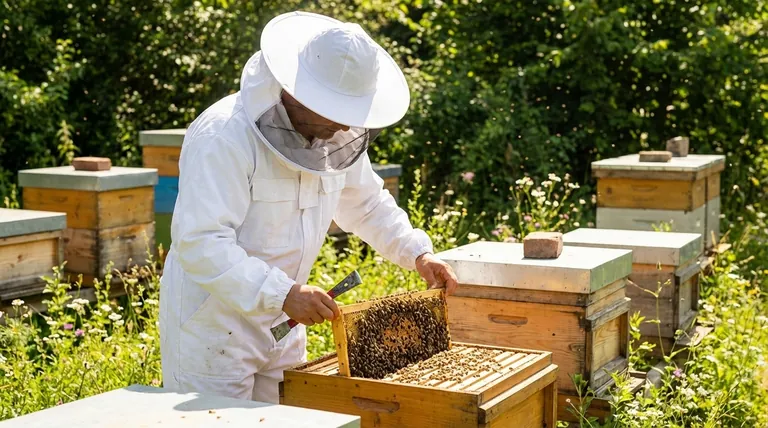The primary reason bee suits are white is for temperature control and bee temperament management. The light color reflects sunlight, keeping the beekeeper cooler during long hours in the apiary, and it presents a non-threatening appearance to the honeybees, reducing defensive behavior.
The choice of white for bee suits is not merely tradition; it is a deliberate decision rooted in bee biology and environmental physics. White is the optimal color for minimizing both heat stress on the keeper and perceived threats to the hive.

The Science of Color: Why White Works Best
Understanding why white is the industry standard involves looking at it from two perspectives: the beekeeper's comfort and the bees' perception. Both are critical for safe and effective hive management.
Maximizing Heat Reflection
A beekeeper's work is often performed under the full sun for extended periods. Dark colors absorb more wavelengths of light, converting them into heat and quickly raising the temperature inside the suit.
White, in contrast, reflects the most sunlight. This simple principle of physics significantly reduces heat buildup, allowing the beekeeper to stay cooler, more focused, and less prone to exhaustion or heat-related illness.
This reflective property also enhances the effectiveness of ventilated suits, as there is less external heat for the ventilation system to overcome.
Minimizing Perceived Threats
To bees, color is a key indicator of danger. Over millions of years, their primary predators—such as bears, skunks, and badgers—have been dark, furry mammals.
Consequently, bees have evolved to be more defensive and aggressive toward dark, moving shapes. A beekeeper in a dark suit is more likely to be interpreted as a predator, triggering a strong defensive response from the colony.
A white suit does not trigger this instinctual alarm. It presents a neutral, non-threatening profile that allows the beekeeper to work more calmly and receive fewer stings.
Enhancing Visibility
A bright white background provides excellent contrast. This makes it easy for the beekeeper to spot stray bees on their suit before leaving the apiary or getting into a vehicle.
This high visibility is also crucial for apiary hygiene and health monitoring. It allows the keeper to quickly see pests like Varroa mites or unusual debris that may have fallen onto the suit from the hive.
Understanding the Trade-offs and Nuances
While white is the ideal, it's important to understand the context and practical limitations. The color is part of a larger safety system.
Does Any Light Color Work?
Yes, other light colors like khaki or light gray are significantly better than black, brown, or navy blue. They offer some of the same heat-reflective and non-threatening benefits.
However, white remains the gold standard because it is the most effective at reflecting heat and is universally recognized as non-threatening to bees. When investing in equipment, there is no practical reason to choose a different light color over white.
The Myth of Invisibility
A white suit does not make you invisible or immune to stings. It simply reduces the likelihood of provoking a defensive response based on color alone.
Other factors, such as quick, jerky movements, strong perfumes, or crushing a bee, will still trigger alarms within the hive. The suit's color is a tool for risk reduction, not risk elimination.
The Downside: Stains and Dirt
The most obvious drawback of a white suit is that it shows dirt, grass stains, and propolis (a sticky resin bees produce) very easily. While this can be an aesthetic issue, it does not impact the suit's primary functions. Most experienced beekeepers view a stained suit as a sign of a well-worked apiary.
Making the Right Choice for Your Goal
Selecting beekeeping gear is about prioritizing safety and effectiveness for your specific situation.
- If your primary focus is maximum safety and adherence to best practices: A full, one-piece white bee suit is the unequivocal best choice.
- If you are beekeeping in an extremely hot climate: Prioritize a fully ventilated white suit to combine the benefits of heat reflection with active air circulation.
- If your primary goal is spotting hive pests: A clean white suit offers the best possible contrast for identifying Varroa mites or other small insects on your person.
Ultimately, understanding the reasoning behind your equipment empowers you to be a more confident and effective beekeeper.
Summary Table:
| Benefit | Key Takeaway |
|---|---|
| Temperature Control | White fabric reflects sunlight, keeping the beekeeper cooler during long hours in the apiary. |
| Bee Temperament | Presents a non-threatening appearance, significantly reducing defensive behavior and stings. |
| Visibility & Hygiene | White background makes it easy to spot stray bees and pests like Varroa mites for better apiary health. |
Ready to experience the difference professional-grade equipment makes?
For commercial apiaries and distributors, the right gear is not just about safety—it's about productivity and profitability. HONESTBEE supplies durable, high-performance beekeeping supplies and equipment designed for the demands of wholesale operations.
Contact HONESTBEE today to discuss how our wholesale-focused solutions can enhance your beekeeping efficiency and bottom line.
Visual Guide

Related Products
- Cotton Beekeeping Suit and Round Hat with Veil Bee Keeper Protective Gear
- White Beekeeping Protective Suit and Hat with Fencing Veil for Beekeepers
- Heavy Duty Cowboy Beekeeper Hat with Visibility Veil Outdoor Professional Beekeeping Protective Gear
- Professional Beekeeping Suit for Kids and Girls Childrens Bee Keeper Suit
- Beekeeper Cowboy Hat and Veil for Beekeeping
People Also Ask
- Why is a jacket with a hat veil recommended for beekeepers? Essential Protection for Your Face and Neck
- What factors should be considered when choosing a beekeeping suit? Balance Safety, Comfort & Performance
- What are the benefits of a fully ventilated beekeeping suit? Stay Cool and Protected in Hot Climates
- What are bee suits made of? Choosing the Right Material for Maximum Protection & Comfort
- How should a bee suit be cleaned? Protect Your Investment and Ensure Apiary Safety



















